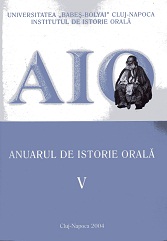ASPECTE DE VIAŢĂ COTIDIANĂ ÎN GRUPURILE DE REZISTENŢĂ DIN ZONA HUEDIN (II)
EVERYDAY LIFE ASPECTS OF THE RESISTANCE GROUPS IN HUEDIN AREA
Author(s): Almira ŢenteaSubject(s): History
Published by: Argonaut
Summary/Abstract: The information used in this study has been selected from interviews recorded during a research campaign in the Apuseni Mountains. The interviews were focused on three resistance groups in the Huedin area: “Şuşman” Group, “Capota-Dejeu” Group, and “Cross and Sword” Group. Proving to be necessary documentation to rewrite the recent history, the information provided by these interviews also reveals an important personalized side of everyday life, habits and attitudes that people develop in order to survive and fit in the newly created historical context. The everyday life’s constants and also the subtle changes that Romania would generate within this area, represent the marks between which this study develops. Due to self-relating to the great history’s pressure, the storyteller’s experiences are grouped into segments, and a subjective manner of grouping events replaces the natural, chronological one. The three main moments in the past that have been reconstituted through the witnesses’ stories, having as central point the resistance phenomenon, are: activities inside the group or activities of providing support from outside the group; dramatic experiences inside a prison; social rehabilitation within a completely changed world, having to carry the stigma of ex-political convicts or of families that went down the social hierarchy - a hierarchy that had been reinserted in the villages under the pressure of the communist regime. The last of the three also reveals the fact that, at rural level, a masked refusal to turn the traditional selecting values upside down and choose such classifications as “party activist”, “member of the Communist Party” or“procollectivization model peasant” existed without any doubt. This confusion of social values, which would certainly touch the entire Romanian society, had only partial effect on some of the partisans’ status: it was to be reconfirmed by the help that a part of the community provided especially after their prison release or after their return from the deportation areas. The aspects I focused on regard strictly the partisans’ activity (starting with their resistance motivation, food necessities, shelter and survival strategies, and their relationship with the villagers, which developed even after their hiding in the mountains) as well as their activities’ influence on the villages they used to live or activate in. I tried to find common elements connecting the groups’ experiences instead of organizing the material on types of resistance groups. The documentary material on “Şuşmman” group is richer in elements that are useful to this type of historical reconstitution due to its longer existence and to its tighter connection with the villages in the area. “Cross and Sword” group had a shorter existence, most of its members being caught in the spring of 1949, while the clandestine actions of Iosif Capota and Alexandru Dejeu involved only few villagers and the impact on the community’s life was weaker...
Journal: Anuarul Institutului de Istorie Orală
- Issue Year: 2004
- Issue No: V
- Page Range: 184-211
- Page Count: 28
- Language: Romanian

